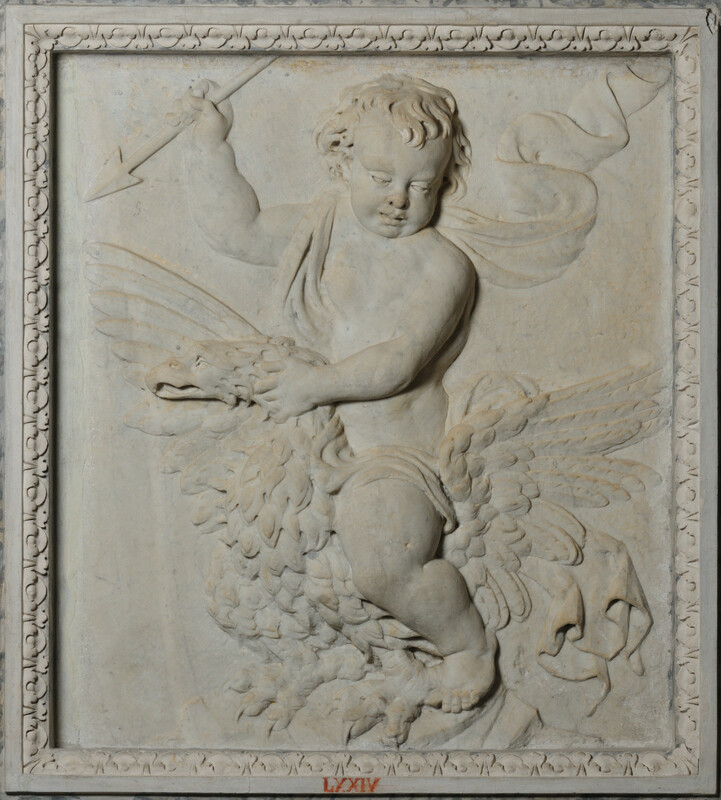Love Triumphant
(Sesto Fiorentino 1562 - Rome 1629)
This small-format bas relief depicts a spirited Cupid with a malicious expression on his face. He brandishes an arrow while riding an eagle, one of the heraldic animals of the Borghese family. The noticeably chubby god holds onto the neck of the bird, which rests on a rock as it visibly struggles to bear such a weight. Part of the garment which partially covers Cupid’s body flows in the wind behind him, reaching the upper right-hand corner of the relief; the rest of the drape, meanwhile, shows deep folds behind the eagle in the lower right portion of the composition. Cupid’s hair is well-defined, with a dishevelled lock falling over his forehead; by contrast the rendering of his chest is less precise, as a way of drawing attention to the softness of his flesh. The work was placed on a wall in Room 1 in the context of the decorative project for the Villa led by Antonio Asprucci, presumably around 1780. The bas relief has been ascribed to Pietro Bernini on the basis of the interpretation of several payment receipts made out to him; although these documents do not indicate the name of the work for which remuneration was made, critics believe that the stylistic similarities of this piece with others by the artist justify the attribution to him.
Object details
Inventory
Location
Date
Classification
Period
Medium
Dimensions
Provenance
Inventario Fidecommissario Borghese, 1833, p. 44; purchased by Italian state, 1902.
Conservation and Diagnostic
- 1996/ 1997 Consorzio Capitolino
Commentary
This bas relief depicts Cupid riding an eagle, holding on tightly to its neck. His gaze is directed downward as he brandishes an arrow in his right hand, perhaps in search of a victim. His expression is cunning and impudent, in keeping with the character of the god who has the power to upset human and divine lives by instilling love or repulsion in their hearts.
‘We see here Cupid on an eagle with a dart in his hand, depicted in modern bas relief’: thus did Montelatici (1700, p. 72) characterise the small composition which he saw on a wall positioned so as to provide a view of one of the avenues which formed the second ring around the Villa. Scholars believe that his description clearly refers to the work in question (D’Onofrio 1967, p. 258).
The bas relief was first documented inside Villa Pinciana in 1796 (Lamberti, Visconti, II, p. 46), when it was located in Room 1, incorporated into the wall that borders the Entrance Hall. The work had probably been moved to this position in the context of the renovation of the building ordered by Marcantonio IV Borghese and carried out by the architect Antonio Asprucci between 1775 and 1785. While Faldi believed that the work was actually executed during that project (1954, p. 18), Fruhan upheld the veracity of Montelatici’s observation, although she disputed his description of its location, proposing rather that it had been executed for the façade of the Villa. Yet this critic did not take a position on the question of the work’s attribution (Fruhan 1986, p. 551 no. 174).
The discovery of several receipts for payments made by the Borghese family to Pietro Bernini led D’Onofrio to propose that some of these supported the attribution of the bas relief to him. In addition, he suggested that Cupid’s dishevelled appearance and his facial features recall those of a bas relief depicting the Assumption, which Bernini executed for the exterior of the Cappella Paolina in the Basilica of Saint Mary Major between 1607 and 1610 (D’Onofrio 1967, pp. 258-9). By contrast, Kessler does not mention the relief in his 2005 monograph on the artist.
Born in Tuscany, Pietro Bernini worked for two decades in Naples, where his son Gian Lorenzo was born in 1598. He then moved to Rome in 1605-06. He created numerous sculptures upon commissions from the Borghese family: in addition to the above-mentioned Assumption – today in the baptistery of Saint Mary Major – he executed the Coronation of Clement VIII for the Cappella Paolina (1611-13) and the Angel to the left above the main door to the Cappella Paolina in Quirinal Palace (1616-17). He further sculpted the Marcus Curtius, boundary stones and other decorative pieces for Villa Borghese; the last-named works were produced in collaboration with his son.
Sonja Felici
Bibliography
- D. Montelatici, Villa Borghese fuori di Porta Pinciana con l’ornamenti che si osservano nel di lei Palazzo, Roma 1700, p. 72.
- L. Lamberti, E.Q. Visconti, Sculture del palazzo della Villa Borghese detta Pinciana, Roma 1796, II, p.46.
- A. Nibby, Roma nell’anno MDCCCXXXVIII. Parte seconda moderna, Roma 1841, p. 915.
- A. Venturi, Il Museo e la Galleria Borghese, Roma 1893, p. 21.
- P. Della Pergola, La galleria Borghese in Roma, Roma 1951, p. 7.
- I. Faldi, Galleria Borghese. Le sculture dal sec. XVI al XIX, Roma 1954, p. 18, cat. 14, fig. 14.
- C. D’Onofrio, Roma vista da Roma, Roma 1967, pp. 258-259.
- H. Hibbard, Bernini Pietro, in Dizionario Biografico degli Italiani, vol. 9, Roma 1967, pp. 376-377.
- Le collezioni della Galleria Borghese, Roma-Milano 1981, p. 104.
- C.E. Fruhan, Trends in Roman Sculpture circa 1600, Michigan 1986, pp. 510-511, 551 n. 174.
- P. Moreno, C. Stefani, Galleria Borghese, Milano 2000, p. 78, fig. 20.
- M.C. Terzaghi, Bernini padre, figlio e cognato: nuovi dati e aperture, in Decorazione e collezionismo a Roma nel Seicento, a cura di F. Cappelletti, Roma 2003, pp. 101-106.
- H.U. Kessler, Pietro Bernini 1562-1629, Monaco 2005.
- Scheda di catalogo 12/01008601, Russo L., 1983; agg. Felici S., 2020.


